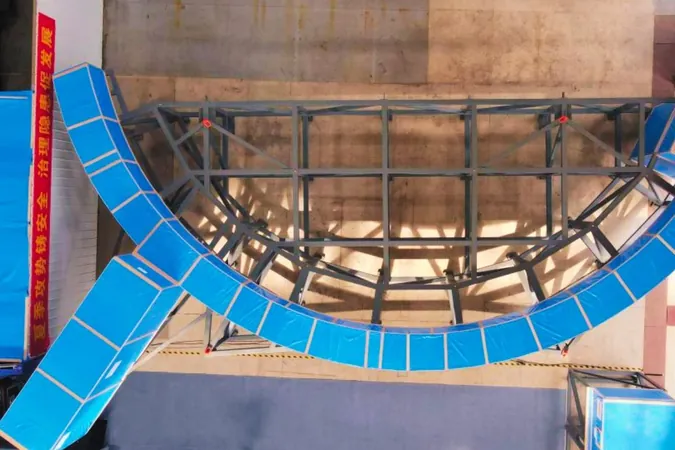
The Giant ‘Monster’ Powering the Future of Fusion Energy
2025-04-15
Author: Amelia
A Game-Changing Milestone for Fusion Energy
A monumental Chinese-made component has just made its grand entrance to the International Thermonuclear Experimental Reactor (ITER) project in southern France, marking a vital leap towards harnessing fusion energy. This 15-meter 'monster' is set to revolutionize how we generate power for generations to come.
China’s Crucial Contribution to the ITER Project
In a groundbreaking achievement this April, China completed the final assembly of the magnetic power supply system for the ITER reactor, currently rising in Cadarache, France. This technological giant measures a staggering 15 meters in diameter and a towering 3 meters tall, with a hefty weight of around 1,600 tonnes. Known as the Correction Coil In-Cryostat Feeders, this component is the culmination of over two decades of collaborative research and development.
Precision Engineering at Its Best
Leading the charge, the Institute of Plasma Physics from the Chinese Academy of Sciences (ASIPP) played a pivotal role in developing this sophisticated system. It ensures the reactor’s superconducting magnets receive power with incredible precision while also acting as a safety valve that can dissipate energy during any instability. Lu Kun, ASIPP's Deputy Director, hailed it as "the most complex system ever supplied by China to ITER," showcasing China's solid commitment to global scientific collaboration, akin to international efforts in space endeavors.
Achieving Extraordinary Engineering Milestones
The intricate design of this power supply system forms the backbone of the ITER reactor’s magnetic containment. Each section underwent intense independent testing in China, ensuring flawless operational performance. Given the extreme precision needed—where even slight fluctuations in temperature or power supply could endanger the entire experiment—this component stands as a testament to human engineering prowess.
A Global Endeavor to Create an Artificial Star
As one of the most ambitious scientific projects ever, ITER involves seven international partners: the European Union, China, the United States, Russia, Japan, India, and South Korea, with a total projected cost of over €22 billion. This endeavor aims to replicate the Sun’s energy-generating process right here on Earth through nuclear fusion, a method that can provide a clean, virtually unlimited energy source.
The Benefits of Fusion Energy That Could Change Everything
The advantages of fusion energy are enormous, including no carbon dioxide emissions during operation, zero long-lived radioactive waste, unparalleled safety compared to nuclear fission, and an abundant fuel source derived from seawater. Furthermore, it boasts a high energy density compared to traditional energy sources. With construction progressing toward its goal of creating a first plasma in the next few years, the ultimate aim is to achieve net energy production—generating more energy than consumed to initiate the reaction—a milestone that could redefine our energy landscape.
The Status of Fusion Research in 2025 and Beyond
While ITER spearheads international fusion research, nations worldwide are delving into their own initiatives. China’s Experimental Advanced Superconducting Tokamak (EAST) previously held the record for maintaining plasma for 1,000 seconds, only to be outdone by France’s WEST tokamak, achieving a 22-minute duration. Moreover, China is pioneering the world’s first hybrid fusion-fission reactor expected by 2030.
Dedication in the Race for Fusion Energy
The intensity of fusion research demands extraordinary commitment from scientists and engineers, who often work under grueling conditions akin to vigorous athletic training—targeting transformative breakthroughs.
The Future of Energy Awaits—Will ITER Deliver?
As ITER stands poised at a critical crossroads, it has the potential to symbolize our shift toward a carbon-free energy future—or could falter if plasma control proves challenging. With every component now aligning within this massive scientific jigsaw, and with China’s colossal 15-meter contribution, humanity inches closer to grasping the stellar power of fusion energy.









 Brasil (PT)
Brasil (PT)
 Canada (EN)
Canada (EN)
 Chile (ES)
Chile (ES)
 Česko (CS)
Česko (CS)
 대한민국 (KO)
대한민국 (KO)
 España (ES)
España (ES)
 France (FR)
France (FR)
 Hong Kong (EN)
Hong Kong (EN)
 Italia (IT)
Italia (IT)
 日本 (JA)
日本 (JA)
 Magyarország (HU)
Magyarország (HU)
 Norge (NO)
Norge (NO)
 Polska (PL)
Polska (PL)
 Schweiz (DE)
Schweiz (DE)
 Singapore (EN)
Singapore (EN)
 Sverige (SV)
Sverige (SV)
 Suomi (FI)
Suomi (FI)
 Türkiye (TR)
Türkiye (TR)
 الإمارات العربية المتحدة (AR)
الإمارات العربية المتحدة (AR)